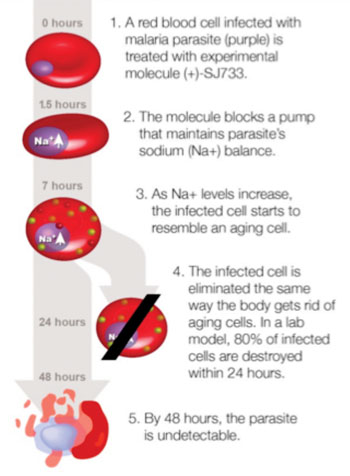Experimental Antimalaria Drug Induces the Immune System to Destroy Infected Red Blood Cells
By LabMedica International staff writers
Posted on 15 Dec 2014
An experimental drug for the treatment of malaria was found to induce morphological changes in infected erythrocytes that enabled the immune system to recognize and eliminate them.Posted on 15 Dec 2014
Investigators at the University of California, San Francisco (USA), St. Jude Children’s Research Hospital (Memphis, TN, USA), and other institutions treated a mouse model of malaria with the candidate drug compound (+)-SJ733. This drug was developed from a dihydroisoquinolone chemical series that had been identified in a phenotypic high-throughput screen. The compound is thought to inhibit the enzyme Plasmodium falciparum Ca2+-ATPase (ATP4), which is a cation-transporting ATPase responsible for maintaining low intracellular sodium ion levels in the parasite.

Image: Disruption and removal of malaria parasites by the experimental drug (+)-SJ733 (Photo courtesy of the University of California, San Francisco).
Results published in the December 1, 2014, online edition of the journal Proceedings of the National Academy of Sciences of the United States of America revealed that in the mouse model, a single dose of (+)-SJ733 killed 80% of malaria parasites within 24 hours, and after 48 hours no parasites were detectable.
In vitro, the treatment of parasitized erythrocytes with (+)-SJ733 caused rapid disruption of sodium ion equilibrium in the parasite. This perturbation was followed by profound physical changes in the infected cells, including increased membrane rigidity and externalization of phosphatidylserine, consistent with eryptosis (erythrocyte suicide) or senescence.
The immune systems of the treated animals responded to these changes in infected erythrocytes by removing them using the same mechanism the body relies on to rid itself of aging red blood cells. Parasites that evolved resistance to (+)-SJ733 were defective in other ways and failed to transmit the disease.
Contributing author Dr. Joseph DeRisi, professor of biochemistry and biophysics at the University of California, San Francisco, said, "The data suggest that compounds targeting ATP4 induce physical changes in the infected red blood cells that allow the immune system or erythrocyte quality control mechanisms to recognize and rapidly eliminate infected cells. This rapid clearance response depends on the presence of both the parasite and the investigational drug. That is important because it leaves uninfected red blood cells, also known as erythrocytes, unharmed."
Further development of (+)-SJ733 and the requisite clinical trials will be conducted by a consortium that includes investigators at St. Jude Children’s Research Hospital, the Swiss-based non-profit organization Medicines for Malaria Venture (Geneva, Switzerland), and the Japanese pharmaceutical company Eisai (Tokyo, Japan).
Related Links:
University of California, San Francisco
St. Jude Children’s Research Hospital
Medicines for Malaria Venture














